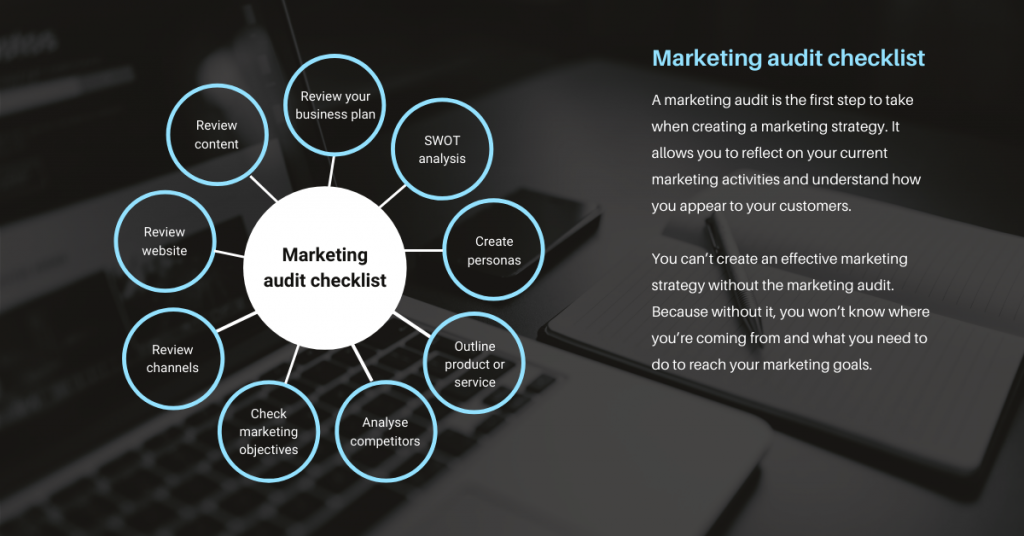A marketing audit is the first step to take when creating a marketing strategy. It allows you to reflect on your current marketing activities and understand how you appear to your customers.
You can’t create an effective marketing strategy without the marketing audit. Because without it, you won’t know where you’re coming from and what you need to do to reach your marketing goals.
I was doing some research on local businesses recently and I noticed that a significant number of them were providing links to non-existent social media accounts, hadn’t posted on accounts for a long time and, in some cases, their websites were down. This is why a marketing audit is so important: it’s a bit like an MOT or vehicle health check for your car. And you wouldn’t drive a car without making sure it was road-worthy!
This is true for all businesses, especially if you’re pivoting your marketing activities at the moment in response to ever-changing circumstances. You shouldn’t completely change your marketing strategy without checking all the basics are in order first.
So what’s the point of a marketing audit?
The point of a marketing audit is to:
- Understand what marketing activities you’re currently doing
- Understand your audience – who are you reaching with your marketing activities and who is your ideal customer?
- Give you a baseline – where are you right now? This is the starting point and once you know this, you’ll be able to decide what marketing activities you need to do to get to where you want to be.
- Benchmark yourself against competitors – how do you look in comparison to them? Why would a customer choose you instead of someone else?
The start of the New Year is a great time to conduct a marketing audit for your business. You have the whole year ahead of you to improve your marketing activities and move your business closer to where you want it to be by this time next year.
Once you have an in-depth understanding of your current marketing position, you’ll be able to make your marketing budget stretch much further and achieve more for your business.
Marketing audit checklist
Review your business plan
Chances are you haven’t looked at this for a while (what with actually running your business!) so refresh your memory before you start reviewing your marketing activities.
SWOT analysis
Conduct a SWOT analysis of your business. If you haven’t come across this framework before, it stands for Strengths, Weaknesses, Opportunities and Threats.
Strengths and Weaknesses are internal and specific to your businesses. For example, a strength could be sector expertise within your business. A weakness may be that you only have one colleague with this particular expertise which limits the amount of work you can take on.
Opportunities and Threats are external factors that could affect your business. For example, an opportunity could be that there are now a lot of virtual networking events. A threat might be that coronavirus restrictions are negatively affecting your key target industry.
Create personas
Who is your ideal customer? This could be existing customers or a new target audience. Either way, take some time to get inside their head and think about their motivations and how they decide to purchase your product or service.
Once you know this, you’ll be able to tailor your communications and marketing activities to resonate with them.
Outline your product or service
Make sure you’re clear on exactly what it is you’re offering, whether that be a product or service. Outline your key features and the problem you solve for your target audience.
As long as you’re clear on your offering, it’ll be a lot easier for you to market it to your customers than if you don’t have your product or service clearly defined.
Analyse your competitors
Ideally, you’re already conducting competitor analysis regularly. However, it’s still good to take a more in-depth look at the competition within your marketing audit. Take a look at their product or service offering compared to yours:
- What are they doing differently to try and gain competitive advantage?
- What channels are they on – are they using any that you aren’t?
- What kind of content are they producing?
- What works with their audience and what is less successful?
Competitors are a great source of market intel, especially on digital channels. Use them as a source of inspiration – if they’re doing something, you can probably do it too, but better!
Check your marketing objectives
If you already have marketing objectives then great! Make sure you review these and see if you’ve managed to achieve them or not.
If you don’t have marketing objectives yet, it’s time to create some. Think about what you want your marketing to achieve over the next 6-12 months. Try to set SMART objectives (specific, measurable, actionable, realistic, time-bound) and identify your key performance indicators that will show you if you’re achieving the objective.
Review your marketing channels
Now take a look at your current marketing channels, both offline and digital. Your channels are where you’re promoting your product or service so you should have a good understanding of what they are, how your business uses them and what audience you’re reaching.
For offline channels, make a note of:
- How often are you using this channel?
- What audience does it reach?
- How much does it cost?
For digital channels, make a note of:
- Key metrics e.g. number of followers/page likes, reach, engagement rate, posting frequency.
- What audience does it reach?
- How much does it cost?
Website review
This could come under the general channel review but as your website is likely to be your main channel, it deserves its own section. To audit your website:
- Check your website structure. Make sure the menu and page structure is logical for visitors to your website. Look out for any broken links – you can use Google Search Console to help find and fix these.
- Check your analytics. If you don’t already have Google Analytics set up on your website then do this so you can get visibility of your web traffic. Some things to look out for are page views, unique users, source/medium, region or country and top pages.
Review your content
Now you’re clear on your marketing channels, it’s important to review what you’re actually saying on them. The areas of content you should review are:
- Website
- Social media
- Advertising
- Brochures/flyers/printed materials
It can be helpful to take screenshots or photos of your content across different channels and put them next to one another. This not only gives you a good visual account of your content, but also helps you check if your content is consistent with the look and feel of your brand.
Once you’ve gone through these stages above, congratulations! You’ve completed your marketing audit! You’re now well on the way to making your marketing more effective and efficient for your business.
If you need help doing marketing audit or creating a marketing strategy, arrange a free 30-minute discovery call with me today.


